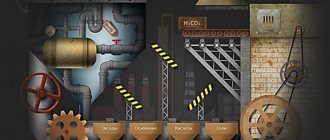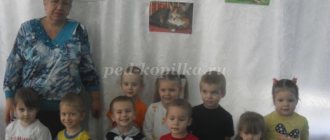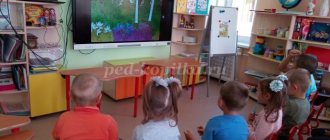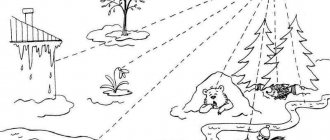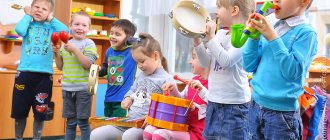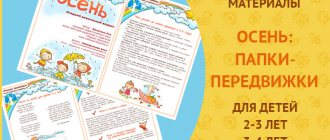Card index of didactic and verbal games on the theme “Autumn”
Card index of didactic and verbal games on the theme “Autumn”
Didactic game “Name the parts of the tree.”
Target:
—
Consolidate knowledge about wood and develop new knowledge.
-Develop memory and thinking.
Progress of the game
:
Together with the children, look at the tree and clarify such concepts as “crown”, “crown”, “trunk”, “branches”, “roots”. Direct inspection will help secure parts of the wood.
Didactic game “Wonderful bag”
Tasks:
-to develop children’s ability to identify a fruit or vegetable by touch by its shape,
- correctly name its color, develop attention, memory, thinking.
Attributes
: bag, dummies of vegetables and fruits.
Progress of the game
: The teacher shows the bag and says:
I'm a miracle bag
I am a friend to all the guys.
I really want to know
How do you like to play?
Children put dummies of vegetables and fruits into a bag. Next, one by one, an object is taken out of the bag, they determine by touch what it is, name it, and then take it out.
Didactic game “Whole and Part”
Tasks:
to develop the child’s ability to select pairs of pictures depicting a whole fruit and its part, to develop oral speech, attention, and memory.
Attributes:
pictures of whole fruits and their parts.
Progress of the game:
2 children are playing. One has pictures of a whole fruit, the other has pictures of a part of it. One player lays out his picture, names what is depicted on it, and the other must choose the corresponding one.
Didactic game “Signs of Autumn”
Tasks:
consolidate knowledge about the signs of autumn, develop oral speech, observation, attention, memory.
Attributes:
cards with signs of autumn (8 pieces) and other seasons (5-6 pieces), a playing field divided into 8 cells.
Progress of the game:
Children (2 people) take turns taking the picture, calling what is drawn on it and determining when it happens. If it is autumn, place the picture on the playing field. If at other times of the year, they put it aside. Next, for each picture, make up a sentence using the keyword “autumn.”
Didactic game “Two Baskets”
Tasks:
improve the ability to distinguish between vegetables and fruits, learn to use generalizing words in speech, develop oral speech, memory, and attention.
Attributes:
two baskets, subject pictures of vegetables and fruits.
Progress of the game:
Children take turns taking a picture, calling what is depicted on it, determining which group it belongs to and putting it in the appropriate basket.
Didactic game “Whole and Part”
Tasks:
develop the ability to select pairs of pictures depicting a whole fruit and its part, develop oral speech, attention, and memory.
Attributes:
pictures of whole fruits and their parts.
Progress of the game:
2 children are playing. One has pictures depicting a whole fruit, the other has pictures depicting a part of it. One player lays out his picture, names what is depicted on it, and the other must choose the corresponding one.
Didactic game “Stocks of animals”
Tasks:
improve the ability to select appropriate food for animals,
develop attention, memory, observation.
Attributes:
pictures of animals, pictures of plants and mushrooms.
Progress of the game:
2 children are playing. Take turns taking a card with pictures of plants or
mushrooms, they say what it is, and put it next to the picture of a certain animal.
Didactic game “What juice?” (“What jam?”)
Tasks:
improve the ability to distinguish and name fruits, teach to form
adjectives, develop oral speech, attention, memory.
Attributes:
basket, pictures of fruits
Progress of the game
: children take turns taking a picture from the basket, calling the pictured fruit and saying what the juice (or jam) from this fruit will be called. For example:
“This apple is apple juice.”
Didactic game “Which tree is the leaf from?” »
Tasks:
to develop the ability to differentiate trees by their trunks and leaves, to develop attention, observation, memory, and imagination.
Attributes:
trunks of three different trees drawn on separate sheets, autumn leaves of these trees.
Progress of the game:
Leaves lie scattered around the patterns of tree trunks. Children should place the leaves on their tree
Didactic game “Which sheet?”
Tasks:
improve knowledge of distinguishing the leaves of three trees, learn to form adjectives, develop oral speech, attention, memory.
Attributes:
basket, autumn leaves.
Progress of the game:
Children sit in a circle and pass the basket to each other. Take turns taking out a leaf, saying which tree it comes from and forming an adjective. For example: this is a sheet with
birch - birch leaf.
Didactic game “Paired pictures”
Tasks:
to develop the ability to correlate pairs of pictures according to the principle of “the whole and its part”, to develop logical thinking, attention, observation, and oral speech.
Attributes
: a set of paired pictures on an autumn theme, where in each pair of pictures a whole image is drawn on one, and on the other its separate part in the form of a separate object (for example: a bird on an autumn branch - an autumn branch).
Progress of the game:
2 children are playing, one has a set of pictures with a whole image, the second has pictures with individual objects. One child takes any of his cards, and the other must choose a pair for her, explaining his choice. Then the second one posts his picture, and the first child selects a match for it.
Word game “Big - small”
Target:
teach children word formation using diminutive suffixes: leaf-leaf, branch-twig, rain-rain, etc.
Word game “Name as many signs as possible”
Target
: teach children to agree nouns with adjectives
Cucumber (what kind?) - oval, crispy, green, long, fragrant
Carrots (what kind?) - orange, long, sweet, healthy, hard
Tomato (what?) - red, juicy, appetizing, round
Onions – juicy, bitter, healthy
Turnip – round, large, sweet
Cabbage is juicy, large, crispy.
Word game “We are a few wizards - there was one, but there are many”
Target:
teach children the formation of the plural of nouns:
Cucumber - cucumbers, apple - apples, pear - ..., plum - ..., peach - ..., banana - .... etc.
Quiz about autumn with answers for preschoolers
Goals:
- Direct participation of parents in the educational process of preschool educational institutions.
- Increasing children's cognitive interest in nature and its study.
Educational:
- Expand children's understanding of the diversity of natural objects and phenomena.
- Learn to navigate the natural world.
Educational:
- Develop the ability to speak as a means of communication and culture.
- Enrich your active vocabulary.
- Develop communication and interaction of the child with adults and peers.
- develop speed of reaction, resourcefulness, intelligence, logical thinking.
Educational:
- Foster love and respect for nature.
- Help to realize the value of joint activities.
- Foster a communicative culture.
Integration of educational areas:
- cognitive development;
- social and communicative development;
- speech development.
Equipment :
- multimedia projector;
- screen;
- hourglass;
- team emblems;
- presentations for the competitions “Barrels-troubles” and “Fabulous”.
The presenter enters the hall to the music.
Presenter: Today 2 teams are participating in the “Lucky Chance” quiz. A team of boys and a team of parents. Let's welcome them.
I invite the teams to take their places. I represent the players of the parents’ team, which is called “Znayki”. Our motto : We are ready for competitions, forward to new victories!
The team of guys is called “Pochemuchki”. Our motto: Let difficult questions lie ahead. We can find all the answers!
Presenter: Will help me conduct the “Lucky Accident” quiz for the jury. (Introduction of the jury members)
For each correct answer, the team receives one point. So, let's start our game.
Let everyone boldly enter into battle, In the excitement of competition, Success will not come by itself. Your knowledge will help.
And now, I ask one of the spectators, using a counting rhyme, to determine which of the teams will be the first to answer the questions.
1 game “Give me a word”
Our first game is called “Give me a word.”
I start a sentence and team members finish it.
Questions for the “Whychek” team:
- The owl flies, and the rabbit...
- The crow croaks, and the dog...
- The bear loves honey, and the cat...
- The little bear has a mother bear, and the little squirrel...
- The wolf howls, and the fly...
- The frog croaks, and the horse...
Questions for the Znaek team:
- The cow eats hay, and the fox...
- The mole digs holes, and the titmouse...
- The bird makes its nest, and the spider...
- The rooster crows and the hen...
- The cow has a calf, the sheep...
- The cat feeds the kittens with milk, and the whale...
Presenter: The distinguished jury announces the results of the 1st competition.
Host: Let's continue our game.
Game 2 “Barrels-troubles”
The next game is called “Barrel Troubles”.
Each team is given the opportunity to pull out a barrel with a task number. The game is very difficult, so I have prepared tips for you. On the screen you see natural objects that will tell you the correct answer. You just need to listen carefully and choose the right clue.
The team is given 10 seconds to discuss the riddle. Let's start with the team...
A team member takes out a keg and announces a number.
1. Striped calf Tied with a string, Lies and gets fat: The older, the sweeter. (Watermelon)
2. I ate grains, became lighter, became limp... Who digs mountains under a hole?
3. Silent during the day, screaming at night, No one understands, but does it scare tramps? (Owl)
4. A red maiden walks across the sky. (Sun)
5. The little animal is jumping, not a mouth but a trap. Both the mosquito and the fly will fall into the trap. (Frog)
6. The more you eat, the more you have leftover. (Nuts)
7. Yashka is standing in a red shirt. Whoever passes by will bow to him. (Berry)
8. He made a hole, dug a hole, the Sun is shining, but he doesn’t know. (Mole)
9. All made of gold, He stands in the sun. (Ear)
10. From branch to branch, fast as a ball, the red-haired circus performer jumps deftly. (Squirrel)
Presenter: The jury gives the floor, announce the results of the 2nd competition.
Game 3 “Proverbs are not said in vain”
Presenter: Our third game is the mini-game “Proverbs are not said in vain.” Members of one team begin the proverb, members of the other finish it.
Let's start with the team...
- Where there is a spider, there is... a “web”.
- Gruzdev called himself get in the body".
- A bird in the hand is worth two in the bush".
- Without difficulty you can’t catch even... “a fish from the pond.”
- Where there is a flower - ... “there is honey.”
- To be afraid of wolves -… “don’t go into the forest.”
Host: After such difficult tasks, let's rest a little.
I know that the guys were preparing a surprise for the teams. And now I think it's time to present it.
Musical pause.
Presenter: The floor is given to the members of the jury. Game 3 results.
Host: And we still have everything ahead. Now is the time for the most amazing, most mysterious game.
Game 4 “Dark Horse”
Guess who our guest is? “The most harmful postman is a village resident who can easily fake a mustache of any length.”
Pechkin: Hello! It was I, postman Pechkin, who brought you telegrams from the forest. The only problem I have is this. Woodpecker, our forest telephone operator, forgot to convey who these telegrams were from. Help me!
Guess who sent them?
- I will help everyone whose alarm clock is broken.
- I am the most charming and attractive! I'll fool anyone you want to deceive. Considering all this, I urge you to call me by my first name and patronymic.
- To the one who finds my tail! Keep it as a keepsake. I will successfully grow a new one.
- I teach all sciences! I make birds out of chicks in a short time. Please note that I conduct classes at night.
- Everyone, everyone, everyone! If anyone has a need for horns, contact me once a year.
- I can help kind but lonely birds find family happiness! Hatch my chicks! I have never experienced maternal feelings. I wish you happiness in your personal life.
Pechkin: Thank you teams for your help, you helped me out. Well, I went, I still need to deliver all the telegrams. Goodbye!
Host: I’ll ask the jury to announce the score. Presenter: Attention! Attention! Let's continue the competition!
Game 5 “Fairytale”
Attention to the screen. Remember the names of the fairy tales whose heroes are depicted here.
The team starts first...
Presenter: Time flies very quickly and we have come to the last game. Before the last test, I will ask the jury to announce the leader.
So, the last game is “Race for the Leader”
Each team needs to answer as many questions as possible in 1 minute.
1. Who is called the forest doctor? 2. Which animal can pretend to be dead? 3. What desert dweller can go without drinking for a week? 4. Leo hairstyle? 5. What is Snow Maiden’s favorite time of year? 6. Deciduous tree with white bark? 7. Winter apartment of a bear? 8. A man-made birdhouse? 9. Flying flower? 10. Horse in a vest? 11. How do trees differ from shrubs? 12. Tallest African animal? 13. How does spruce differ from pine? 14. Who can go out into the open field without leaving their house? (snail). 15. What is the largest animal on the planet? (whale) 16. Which trees have red leaves in autumn? 17. What insect hears with its feet? (grasshopper) 18. Does she wear a red fur coat in summer, and a gray one in winter? (squirrel) 19. A bird that runs fast but doesn’t fly? (ostrich) 20. Part of the day from the end of the day to the beginning of the night? (evening). 21. Fruits and berries boiled in sugar syrup? (jam) 22. What grows with its top down? (icicle) 23. The bird whose legs became the most suitable support for Baba Yaga’s house? 24. Striped insect with a thin waist? (wasp) 25. Who uses his nose instead of his hand? (elephant) 26. The largest lizard in the world? (monitor lizard) 27. Not a person, but talking? (wind) 28. A sea animal with eight legs? (octopus)
Host: Our game is over. While the jury sums up the results, we have a musical break. Host: So, the jury has the floor to announce the results of the game.
Team awards.
Author: Krasnova Natalya Aleksandrovna
Game-activity “Autumn” for children 3 years of age
Summary of a lesson in a playful way for children of the third year of life, topic: “Autumn”
Author: Davydova Svetlana Alekseevna.
Equipment:
Autumn leaves large and small. Leaves of yellow, red and green colors cut out of cardboard and vases (trays, bags, etc.) of the same colors. Puddles cut out of oilcloth. Nuts, a “squirrel” toy, a plastic bottle with a “hollow” cut out. Plasticine in yellow, red and green colors, sheets of paper with a painted tree. Wooden spatulas with red, yellow, green clothespins attached to them. Flowers and flower beds cut from egg cages, finger paints. Glue, sheets of paper with a background “autumn, tree trunks without a crown). Musical children's instruments. Audio recordings: “Waltz of the Flowers” by P. I. Tchaikovsky, song “Autumn, autumn has come, the leaves are falling.”
Didactic game "Autumn"
Didactic game “Number. Sign. Subject" on the lexical topic "Autumn"
The game is intended for children aged 4-6 years with severe speech impairments, as well as for children of preschool and primary school age to develop the lexical and grammatical structure of speech.
Didactic game “Number. Sign. Subject" can be used both in individual and subgroup lessons with children.
Target:
This set of games will help an adult teach a child:
- agree nouns with numerals and adjectives in gender, number, and case.
- select qualitative, relative, possessive adjectives for nouns.
- use ordinal numbers in speech, coordinate them with nouns and adjectives in gender, number, case.
- activate mental activity, associative thinking;
- make comparative sentences with the conjunction “a”.
Material for the game:
cards with game tasks in two subjects of the same lexical group; playing field and cut cards for independent selection and compilation of a plot series; sets of numbers.
Game description:
Game with ready-made models: each table contains tasks for two subjects of the same lexical group for a larger educational load. At the beginning of the game, the child needs to be clearly shown how associations can be used to indicate the characteristics of objects. For example, how can you depict a bitter taste, show the hardness, softness, juiciness of vegetables, color and shape.
Below are ready-made game cards:
- two oval deep puddles;
- six large cold drops;
- one round cold sun;
- five short cold autumn days;
- two autumn cold rains;
- seven autumn cold winds;
- one autumn mahogany;
- four autumn blue clouds.
The game requires compliance with the following steps:
- Name a word denoting a number (what number? - one).
- Name a word denoting an object (what is it? - tree).
- Agree the noun with the numeral in gender (how many trees? - three is one).
- Name the words denoting the attribute of an object, coordinate them with numerals and nouns in gender, number (one tree (which?) - red in autumn).
- Agree the numeral with the adjectives and nouns in gender and number. (Say in a complete sentence, starting with a number. – One autumn red tree.)
- Using the same principle, consider another subject of the lexical group - a cloud.
- Make comparative sentences with the conjunction “a”. (There is one tree, and there are four clouds. The tree is red, and the cloud is blue.)
Game with cut cards : played on the same principle as with ready-made models. Only here the child takes an active position and is given more independence.
First, you should invite the child to choose an item on a lexical topic and place it in a sector with an asterisk, then a number (place in the first sector) and select adjectives in the form of picture symbols (place in the longest sector of the playing field). The symbol pictures are first reviewed and what they mean is explained.
To better understand the progress of the game with cut cards, a sample is provided below.
Using the didactic game “Number. Sign. Subject" children will quickly master the skills of agreeing adjectives, nouns and numerals in gender, number, case; will learn to select adjectives for nouns and develop their associative thinking.
The development of associative thinking has a positive effect on the process of memorizing and reproducing necessary information.
On our website you can find other educational games from the “Number” series. Sign. Item". To do this, follow the highlighted link .
We wish everyone success.
